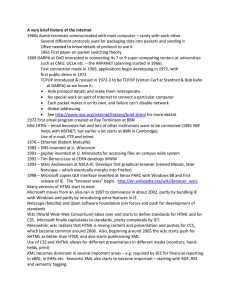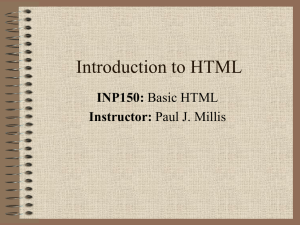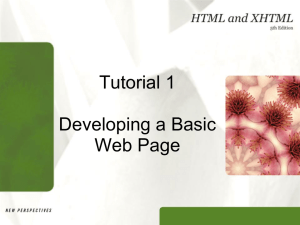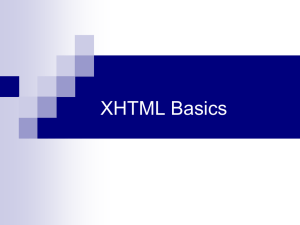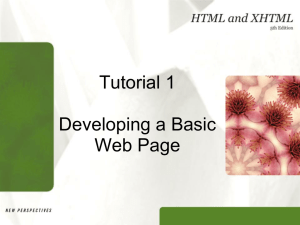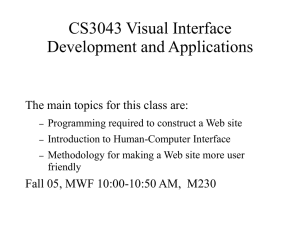XML parser - C. Morris
advertisement
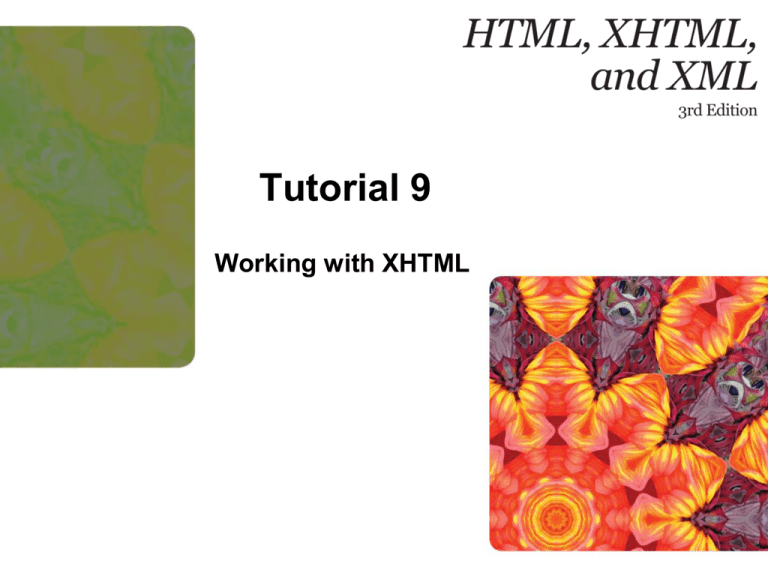
Tutorial 9 Working with XHTML Objectives • Describe the history and theory of XHTML • Understand the rules for creating valid XHTML documents • Apply a DTD to an XHTML document • Understand how to apply the XHTML namespace • Test an XHTML document under the transitional DTD and the strict DTD. • Explore the use of character and parsed character data New Perspectives on HTML, XHTML, and XML, Comprehensive, 3rd Edition New Perspectives on HTML and XHTML, Comprehensive 2 Introducing XHTML • SGML (Standard Generalized Markup Language) – Device-independent and system-independent – Introduced in the 1980s – Not intended for the World Wide Web • HTML – Standards get confusing among browsers – Can be and ARE applied inconsistently by browsers – huge problem for programmers right now. New Perspectives on HTML, XHTML, and XML, Comprehensive, 3rd Edition New Perspectives on HTML and XHTML, Comprehensive 3 History of XHTML New Perspectives on HTML, XHTML, and XML, Comprehensive, 3rd Edition New Perspectives on HTML and XHTML, Comprehensive 4 Creating an XHTML Document • The first line of an XTHML document should contain a declaration indicating that the document adheres to the rules and syntax of XML • XML (and thus XHTML) documents are based on a character set – A character set is a set of abstract symbols matched to code numbers New Perspectives on HTML, XHTML, and XML, Comprehensive, 3rd Edition New Perspectives on HTML and XHTML, Comprehensive 5 Character Sets • Universal Character Set (UCS) • Unicode • Character encoding is the process in which bytes are translated back into characters (when a document is sent across the Internet) New Perspectives on HTML, XHTML, and XML, Comprehensive, 3rd Edition New Perspectives on HTML and XHTML, Comprehensive 6 Adding an XML Declaration • To declare that a document is written in XML, enter the following as the first line of the file: – <?xml version=“value” encoding=“type” standalone=“type” ?> – Where the version attribute indicates the XML version of the document, the encoding attribute specifies the character encoding, and the standalone attribute indicates whether the document contains references to an external DTD • For XHTML documents, use the declaration: <?xml version=“1.0” encoding=“UTF-8” standalone=“no” ?> New Perspectives on HTML, XHTML, and XML, Comprehensive, 3rd Edition New Perspectives on HTML and XHTML, Comprehensive 7 Introducing XHTML • XML (Extensible Markup Language) – Used to create markup languages • XML documents must be evaluated with an XML parser • An XML document with correct syntax is a well-formed document • A well-formed document with correct content and structure is a valid document • DTD specifies correct content and structure • DTD = DOCUMENT TYPE DEFINITION – this is a collection of rules for XML documents. New Perspectives on HTML, XHTML, and XML, Comprehensive, 3rd Edition New Perspectives on HTML and XHTML, Comprehensive 8 Introducing XHTML New Perspectives on HTML, XHTML, and XML, Comprehensive, 3rd Edition New Perspectives on HTML and XHTML, Comprehensive 9 Creating a Well-Formed Document New Perspectives on HTML, XHTML, and XML, Comprehensive, 3rd Edition New Perspectives on HTML and XHTML, Comprehensive 10 Creating a Well-Formed Document • XHTML documents must also include a single root element that contains all other elements – For XHTML, that root element is the html element • Attribute minimization is when some attributes lack attribute values – XHTML doesn’t allow attribute minimization New Perspectives on HTML, XHTML, and XML, Comprehensive, 3rd Edition New Perspectives on HTML and XHTML, Comprehensive 11 Attribute minimization in HTML and XHTML New Perspectives on HTML, XHTML, and XML, Comprehensive, 3rd Edition New Perspectives on HTML and XHTML, Comprehensive 12 DTDs - Transitional: supports many of the presentational features of HTML, including the deprecated elements and attributes. Best used for older documents that contain deprecated features. - Frameset: used for documents containing frames, and also supports deprecated elements and attributes - Strict: does not allow any presentational features or deprecated HTML elements and attributes. Does not support frames or inline frames. It is best used for documents that need to strictly conform to the latest standards New Perspectives on HTML, XHTML, and XML, Comprehensive, 3rd Edition New Perspectives on HTML and XHTML, Comprehensive 13 Creating Valid XHTML Documents • The DTD used depends on the content of the document and the needs of your users • To support old browsers, use the transitional DTD • To support old browsers in a framed Web site, use the frameset DTD • To support more current browsers and to weed out any use of deprecated features, use the strict DTD New Perspectives on HTML, XHTML, and XML, Comprehensive, 3rd Edition New Perspectives on HTML and XHTML, Comprehensive 14 Creating a Valid Document • Elements not allowed under the strict DTD: – applet - iframe – basefont - isindex – center - menu – dir - noframes – font -s – frame - strike – frameset -u New Perspectives on HTML, XHTML, and XML, Comprehensive, 3rd Edition New Perspectives on HTML and XHTML, Comprehensive 15 Creating a Valid Document • Some attributes are restricted, while others are required in XHTML • Let’s look at what is restricted vs. what is required. New Perspectives on HTML, XHTML, and XML, Comprehensive, 3rd Edition New Perspectives on HTML and XHTML, Comprehensive 16 Attributes Prohibited in the Strict DTD New Perspectives on HTML, XHTML, and XML, Comprehensive, 3rd Edition 17 Required XHTML Attributes New Perspectives on HTML, XHTML, and XML, Comprehensive, 3rd Edition New Perspectives on HTML and XHTML, Comprehensive 18 Inserting the DOCTYPE Declaration • You can also add the DOCTYPE declaration, which tells XML parsers what DTD is associated with the document <!DOCTYPE root type “id” “url”> New Perspectives on HTML, XHTML, and XML, Comprehensive, 3rd Edition New Perspectives on HTML and XHTML, Comprehensive 19 The XHTML Namespace • A namespace is a unique identifier for elements and attributes originating from a particular document type (like XHTML or MathML) • Two types of namespaces: - Default: applied to a root element and any element within it - <root xmlns=“namespace”> New Perspectives on HTML, XHTML, and XML, Comprehensive, 3rd Edition New Perspectives on HTML and XHTML, Comprehensive 20 The XHTML Namespace • Local: applies to only select elements – Each element in the local namespace is marked by a prefix attached to the element name – xmlns: prefix=“namespace” – Identify any element belonging to that namespace by modifying the element name in the tag: • prefix:element New Perspectives on HTML, XHTML, and XML, Comprehensive, 3rd Edition New Perspectives on HTML and XHTML, Comprehensive 21 Setting the XHTML Namespace • To set XHTML as the default namespace for a document, add the xmlns attribute to the html element with the following value: – <html xmlns=http://www.w3.org/1999/xhtml> New Perspectives on HTML, XHTML, and XML, Comprehensive, 3rd Edition New Perspectives on HTML and XHTML, Comprehensive 22 Testing an XHTML Document • To test your document, you need to send the file to an XML parser – Several are available on the Web • IMPORTANT POINT --- Sometimes the same mistake results in several errors noted in the report – Fixing one mistake can solve several errors New Perspectives on HTML, XHTML, and XML, Comprehensive, 3rd Edition New Perspectives on HTML and XHTML, Comprehensive 23 Testing an XHTML Document New Perspectives on HTML, XHTML, and XML, Comprehensive, 3rd Edition New Perspectives on HTML and XHTML, Comprehensive 24 Successful Validation Under XHTML Transitional New Perspectives on HTML, XHTML, and XML, Comprehensive, 3rd Edition New Perspectives on HTML and XHTML, Comprehensive 25 Testing an XHTML Document • To test under another DTD, you’ll need to change the DOCTYPE declaration New Perspectives on HTML, XHTML, and XML, Comprehensive, 3rd Edition New Perspectives on HTML and XHTML, Comprehensive 26 Using Style Sheets and XHTML • Parsed character data (PCDATA) is text parsed by a browser or parser • Unparsed character data (CDATA) is text not processed by the browser or parser – A CDATA section marks a block of text as CDATA so that parsers ignore any text within it New Perspectives on HTML, XHTML, and XML, Comprehensive, 3rd Edition New Perspectives on HTML and XHTML, Comprehensive 27 XML PARSING LINKS Examples - http://www.w3schools.com/xml/xml_examples.asp Validator http://validator.w3.org/docs/api.html New Perspectives on HTML, XHTML, and XML, Comprehensive, 3rd Edition 28
